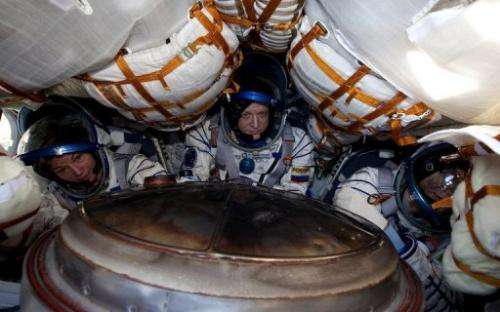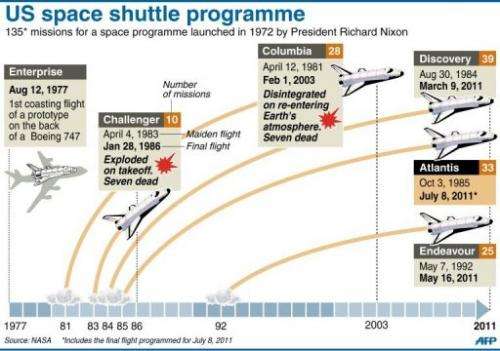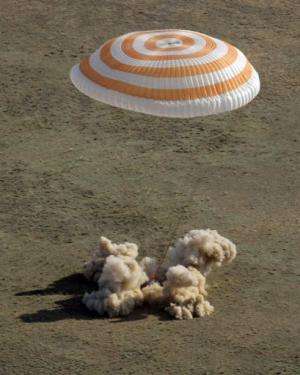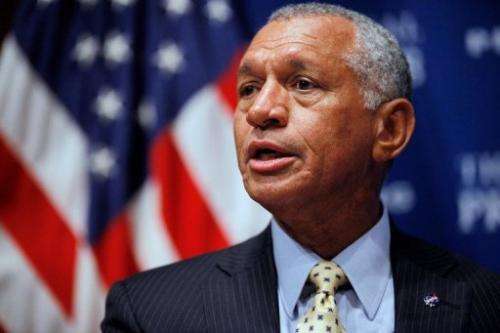Long, cramped road trips ahead for US astronauts

If you think of the shuttle as a kind of big space bus, the future for US astronauts will be a lot like squeezing into a three-seat compact car, made by Russia, for a very long road trip.
With the shuttle program ending once Atlantis returns to Earth on July 21, US astronauts will be flying much less often to the International Space Station.
And when they do, they will be hitching a ride aboard a Soyuz space capsule at a cost of $51 million per seat next year. In 2013 the cost goes up to $55.9 million, and in 2014 it rises to $62.7 million.
NASA has said the increase covers "general inflation in Russia in the cost of providing the services," at a rate of about 8.5 percent.
The prospect of paying a former Cold War foe has raised the hackles of some Americans, and left NASA defending its aim to build a long-haul spacecraft for Mars by 2030 while private industry hustles to replace the shuttle with a new capsule by 2015.
"It is a shame that for many of us that simply want to preserve, protect, and defend our leadership in space that we see NASA paying for rides to the Space Station from countries that may not have America's best interests at heart," said Congressman Ralph Hall, a Republican from Texas.
Questioned by House lawmakers this week about the rising costs to pay Russia, NASA administrator Charles Bolden said: "It is not just for a ride. It is for training because our crew members fly as crew members of the Soyuz spacecraft."
Since the shuttle program resumed flights after Columbia exploded on its way back to Earth in 2003 due to a damaged heat shield, US astronauts have grown accustomed to frequent flights to space.
From 2005 through the final mission of Atlantis, NASA averaged three trips per year and brought a total of 133 American astronauts to space along with a dozen astronauts from other space agencies.

Six to seven crew members were aboard each trip -- sometimes all of them were Americans and other times one seat went to an astronaut from Japan, Europe or Canada.
In the future, opportunities for Americans to travel to the ISS will be limited to about three to four per year -- a far cry from the not so distant past when NASA sent an average of 22 astronauts to space per year.
US astronauts need to devote more than two years of special training in Russian language courses and space engineering in order to be considered for a trip to the ISS.
And each mission aboard the orbiting outpost lasts up to six months, compared to the summer-vacation-length jaunts of two weeks at a time during the shuttle era.
While NASA reels from the job losses incurred with the shuttle program's end, Bolden -- a former astronaut himself -- admitted the once high-prestige posts have become less appealing.

"One of the things that is unattractive, if you will, to a young astronaut with a family is having to spend two years of their time, back and forth to Russia. It is not attractive," Bolden told lawmakers on Tuesday.
Since 2000, the size of the American astronauts corps has dwindled dramatically, from 128 back then to just 61 now.
Some astronauts are jumping ship for higher salary offers with private companies working on building the next space capsule capable of taking humans to low Earth orbit.
Those who remain, like US astronaut Terry Virts who piloted the shuttle Endeavour's flight in February last year, are trying to stay focused on the future.
"We are still going to be operating. We will just be launching and landing in Kazakhstan," Virts told AFP in Florida's Cape Canaveral ahead of the final Atlantis launch.

"It will be at least a few more years, if not more, before we are doing that here and that is what I am looking forward to because that's what we need to be doing is launching Americans here from the Kennedy Space Center."
The idea of spending less time in space is already hard for astronauts, who would be up there all the time if they could, said US astronaut Cady Coleman who recently returned from a six-month stint aboard the ISS.
"All of us are addicted to going to space," she said. "If it is the only thing you want to do... this is not the right job. The job of an astronaut is much, much broader than going into space.
"There are never enough opportunities for us to go into space. We always want more. We would go all the time if we could. In that sense, there is always something that makes it a little frustrating."
(c) 2011 AFP



















